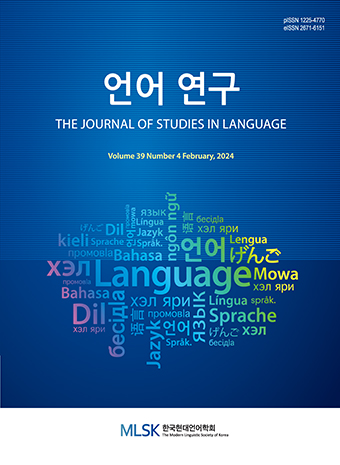Research Article
Abstract
References
Information
The current study explores the textual metafunction in Korean English learners’ writings by examining the Theme choices and the patterns of the Thematic progression in the writings in two different proficiency levels. The analysis of the Theme and Thematic progression can be a useful tool to analyze the writings in that they characterize English learners’ writings based on the linguistic choices they have made. Moreover, it is useful because the writings are examined not just on a structure of a sentence level but on the linguistic resources that writers use to communicate in a larger discourse level. As a result, the present study has found that the high and low level learners have difficulties employing nominalization and existential there in the Theme position of a clause. The utilization of the multiple Theme in both groups does not indicate a meaningful difference between the two groups. However, the employment of markedness of Theme demonstrates a slight difference between the two levels. In terms of Thematic progression, the three typical types of Thematic progression have been found in the study: linear Thematic progression, Thematic progression with constant Theme, and multiple-Rheme. Besides these patterns, some problematic patterns are found in the writings that coincide with the previous research.
- Arunsirot, S. 2013. An Analysis of Textual Metafunction in Thai EFL Students’ Writing. Novitas-Royal Research on Youth and Language 7, 160-174.
- Belmonte, I. A. and A. McCabe-Hidalgo. 1998. Theme-Rheme Patterns in L2Writing. Didáctica 10, 13-31.
- Bloor, M. and T. Bloor. 1992. Given and New Information in the Thematic Organization of Text: an Application to the Teaching of Academic Writing. Occasional Papers in Systemic Linguistics 6, 33-44.
- Butt, D., R. Fahey, S. Feez, and S. Spinks. 2012. Using Functional Grammar: An Explorer’s Guide. 3rd edition. Palgrave Macmillan.
- Christie, F. 1999. Genre Theory and ESL Teaching: A Systemic Functional Perspective. TESOL Quarterly 33, 759-763. 10.2307/3587889
- Christie, F. and S. Dreyfus. 2007. Letting the Secret Out: Successful Writing in Secondary English. Australian Journal of Language and Literacy 30, 235-247.
- Daneš, F. 1974. Functional Sentence Perspective and the Organization of the Text. In F. Daneš (Ed.), Papers on Functional Sentence Perspective. The Hague: Mouton, 106-128. 10.1515/9783111676524.106
- Eggins, S. 2004. An Introduction to Systemic Functional Linguistics. 2nd edition. New York: Continuum.
- Fries, P. H. 1995. Themes, Methods of Development, and Texts. In Hasan, R and Fries, P. H. (eds), On Subject and Theme: from the Perspective of Functions in Discourse. Amsterdam and Philadelphia: John Benjamins, 317-359. 10.1075/cilt.118.10fri
- Halliday, M. A. K. 1985. An Introduction to Functional Grammar. 1st edition. London: Edward Arnold.
- Halliday, M.A.K. and C.M.I.M. Matthiessen. 2004. An introduction to functional grammar. 3rd edition. London: Hodder Arnold.
- Halliday, M.A.K. and C.M.I.M. Matthiessen. 2014. Halliday’s introduction to functional grammar. 4th edition. London: Routledge. 10.4324/9780203783771
- Hawes, T. and S. Thomas. 1997. Problems of Thematisation in Student Writing. RELC Journal 28, 35-55. 10.1177/003368829702800203
- Ishikawa, S. 2013. The ICNALE and Sophisticated Contrastive Interlanguage Analysis of Asian Learners of English. Learner Corpus Studies in Asia and the World 1, 91-118.
- Kim, M. 2004. Coherence and Cohesion in the Narratives of Korean EFL Learners. Discourse and Cognition 10, 31-56.
- Lee, S. 2007. Connectors as Textual Orienting Themes in Korean and Australian Student Essay Writing. English Teaching 62, 121-147. 10.15858/engtea.62.1.200703.121
- Martin, J. R., F. Christie, and J. Rothery. 1987. Social Processes in Education: A Reply to Sawyer and Watson (and others). In I. Reid (Ed.), The Place of Genre in Learning: Current Debates. Geelong, Australia: Deakin University, Centre for Studies in Literary Education, 35-45.
- Matthiessen, C. M. I. M., K. Teruya, and M. Lam. 2010. Key Terms in Systemic Functional Linguistics. London and New York: Continuum.
- Nation, I. S. P. and D. Beglar. 2007. A vocabulary size test. The Language Teacher 31, 9-13.
- Park, K. and D. Nam. 2015. Analysis of Thematic Structure in L2 Writing: A Systemic Functional Perspective. SNU Journal of Education Research 24, 65-88.
- Ping, A. L. 2007. Developing the Message: Thematic Progression and Student Writing. The Journal of Asia TEFL 4, 93-127.
- Schleppegrell, M. J. 2004. The language of schooling: A functional linguistic perspective. Mahwah, NJ: Lawrence Erlbaum Associates.
- Schleppegrell, M. J. 2009. Grammar for Generation 1.5.: A focus on meaning. In M. Roberage, M. Siegal and L. Harklau (Eds.), Generation 1.5 in College Composition: Teaching Academic Writing to U.S.-educated Learners of ESL. New York: Routledge, 221-234.
- Seo, E. 2019. Lexicogrammar as a Meaning-Making Resource: A Systemic Functional Approach to Second Language (L2) Writing in Cross-Border Education. Korean Journal of Applied Linguistics 35, 153-191. 10.17154/kjal.2019.12.35.4.153
- Thompson, G. 2014. Introducing Functional Grammar. 3rd edition. New York: Routledge. 10.4324/9780203785270
- Wang, B. and Y. Ma. 2017. Textual Choices in Rabindranath Tagore’s Stray Birds and Feng Tang’s Chinese Translation. Proceedings of the Sixth Northeast Asia International Symposium on Language, Literature and Translation, 31-37.
- Wang, L. 2007. Theme and Rheme in the Thematic Organization of Text: Implications for Teaching Academic Writing. Asian EFL Journal 9, 164-176.
- Yunita, S. 2018. Theme and Thematic Progression in Students’ Recount Texts. Indonesian Journal of Applied Linguistics 7, 524-530. 10.17509/ijal.v7i3.9797
- Publisher :The Modern Linguistic Society of Korea
- Publisher(Ko) :한국현대언어학회
- Journal Title :The Journal of Studies in Language
- Journal Title(Ko) :언어연구
- Volume : 37
- No :4
- Pages :525-541
- DOI :https://doi.org/10.18627/jslg.37.4.202202.525




 The Journal of Studies in Language
The Journal of Studies in Language






